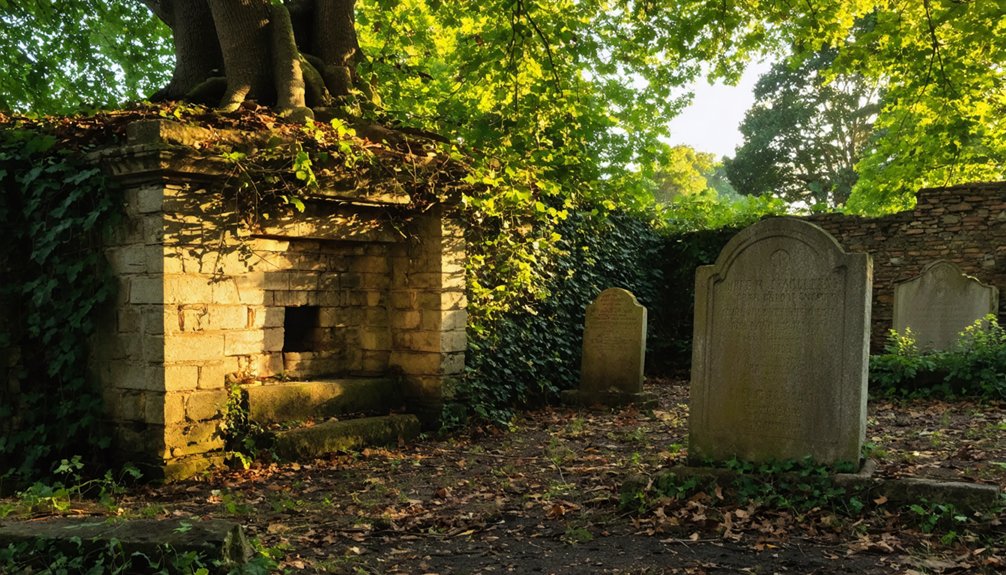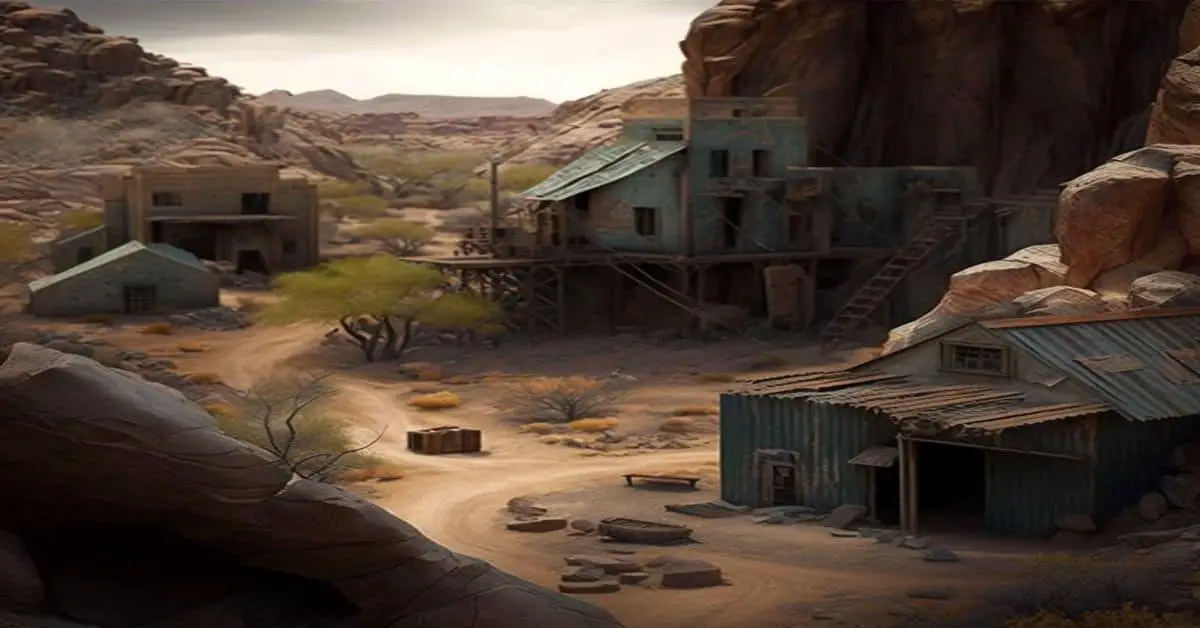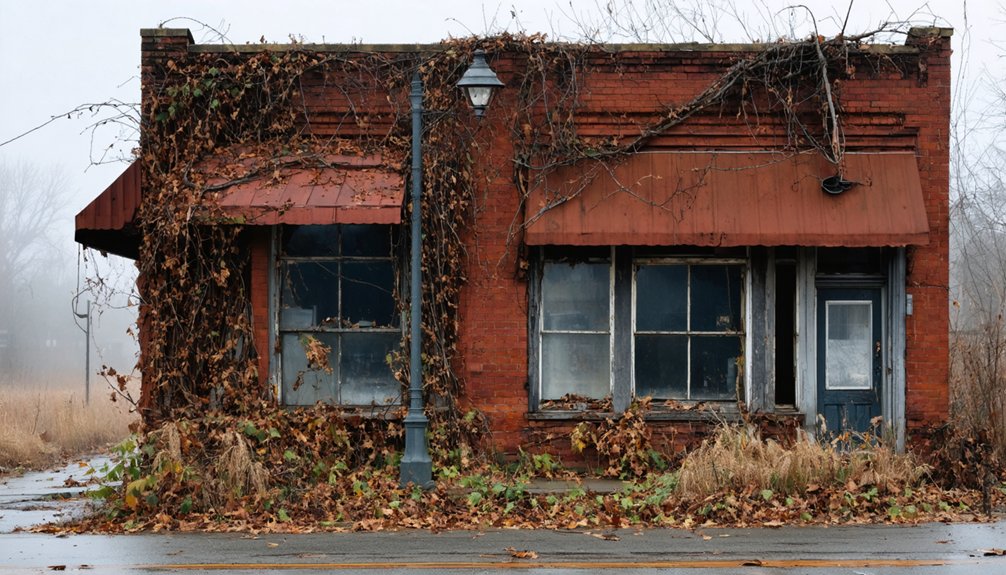You’ll find Lick Creek Settlement‘s remarkable story in Orange County, Indiana, where eleven African American families first settled in 1811. Under Jonathan Lindley’s leadership and with Quaker support, this community grew to 200 families by the mid-1800s, becoming one of America’s earliest free Black settlements. They owned 2,300 acres at their peak and established an AME church that doubled as an Underground Railroad station. Today’s archaeological discoveries continue revealing this ghost town’s powerful legacy of freedom and resilience.
Key Takeaways
- Lick Creek Settlement declined significantly after the Civil War, transforming from a thriving community of 200 families into an abandoned ghost town.
- The settlement’s original 1,557 acres of Black-owned farmland was gradually abandoned as residents moved to urban areas seeking opportunities.
- Archaeological excavations reveal remnants of the once-prosperous settlement, including foundations of the AME church and residential structures.
- The site’s location along Buffalo Trace, a historic migration route, is now preserved as part of Hoosier National Forest.
- Despite its abandonment, Lick Creek represents one of Indiana’s earliest free Black settlements, established before statehood in 1816.
Origins and Early Settlement in Orange County
While Indiana was still a territory, the first African American families arrived in Orange County before 1820, led by Jonathan Lindley as they sought refuge from racial persecution in North Carolina. These freeborn pioneers traveled alongside sympathetic Quakers who provided protection during their westward journey.
The migration impact on the region was significant, as eleven families established what would become the Lick Creek settlement. The area would later require disambiguation pages to distinguish it from other locations sharing the Lick Creek name.
Jonathan Lindley first settled in 1811, before Indiana achieved statehood. By 1817, the first African American landowners began purchasing property directly from the U.S. government.
Benjamin Roberts, Peter Lindley, and Elias Roberts formalized land acquisitions in 1832, creating a contiguous community near present-day Chambersburg. They’d chosen this location along the historic Buffalo Trace, despite its proximity to Kentucky, a slave state. The settlement reached its peak with 2,300 acres of Black-owned land, demonstrating the community’s remarkable growth and economic success.
Quaker Influence and Underground Railroad Connections
You’ll find that Quaker networks played an essential role in Lick Creek’s development, as they provided critical support and protection to African American families migrating from North Carolina’s restrictive environment.
The settlement’s strategic location near the Buffalo Trace and the strong presence of Quaker abolitionists suggest its likely involvement in Underground Railroad activities, though direct documentary evidence remains scarce.
The African Methodist Episcopal church, established in the 1840s, strengthened these freedom partnerships by serving as a potential safe house and community hub for both religious worship and antislavery efforts.
The settlement reached its peak with 200 families by the mid-1800s before experiencing a dramatic decline during the Civil War period.
Quaker Support Networks
Throughout the early 1800s, Quakers established essential support networks in Indiana that proved instrumental for African American settlers seeking freedom and prosperity.
These Quaker networks facilitated land ownership, education, and legal protection for both free Blacks and fugitives. You’ll find evidence of their community support in settlements like Lick Creek, where African Americans like William Constant and Charles Goin purchased land by 1817.
Notable Quaker families like the Truebloods and Thompsons assisted escaping slaves through the Underground Railroad network in southern Indiana. The Olive Branch Church was closely connected to Quaker communities and provided support to early Black settlers in the region.
Quakers sponsored freedom certificates and helped establish schools, including the Union Literary Institute in Randolph County. They created an environment where African Americans could build stable communities with their own institutions.
Through reading circles, sewing groups, and collaborative projects, Quakers provided ongoing assistance that enabled Black families to achieve economic independence and educational advancement despite the hostile legal climate of the era.
Underground Railroad Safe Houses
As freedom seekers crossed the Ohio River from Kentucky into Indiana, Lick Creek’s strategic location 20 miles north of the border made it an ideal Underground Railroad waystation.
The settlement’s integrated community of over 1,000 African Americans and Quakers maintained a network of fugitive shelters through AME churches and private homes. By 1840, African American landowners controlled 780 acres, providing essential resources and safe houses for runaways evading slave catchers. The Federal Fugitive Law of 1850 only strengthened the community’s resolve to protect those seeking freedom. Like the Coffin House in Fountain City, these stations provided crucial shelter to over 1,000 freedom seekers.
You’d find secret routes carefully planned between stations spaced 10-20 miles apart, with conductors moving small groups under cover of darkness.
While direct documentation remains scarce due to the illegal nature of these activities, oral histories confirm Lick Creek’s crucial role in sheltering freedom seekers as they journeyed north toward safety in free states or Canada.
Religious Freedom Partnerships
The foundation of Lick Creek’s Underground Railroad success stemmed from its unique religious partnerships between Quakers and free African Americans. Through community collaboration, the Lick Creek Monthly Meeting served as both a spiritual center and civic hub where racial integration flourished, unlike most pre-Civil War settlements.
You’ll find that Quakers and African Americans worshipped side by side, with the AME Church emerging in the 1840s to provide additional spiritual leadership for Black residents. The Quakers’ belief in the Inner Light within each person reinforced their commitment to racial equality. Led by Lewis Thomas, many families fled from North Carolina to Indiana in 1815 to escape the growing intolerance of slavery.
This faith unity created a powerful foundation for resistance against slavery. The Quakers’ commitment to equality and nonviolence merged seamlessly with African Americans’ pursuit of religious liberty.
Together, they established a rare model of interracial cooperation, where shared religious values strengthened their resolve to help others escape bondage.
Growth and Development of the Black Community
While racial persecution drove many African Americans northward from North Carolina, eleven pioneering Black families found refuge in Orange County, Indiana by 1811, led by Jonathan Lindley and supported by sympathetic Quakers.
Fleeing racial oppression, brave Black families journeyed north to Indiana, finding sanctuary through Quaker support and community solidarity.
This initial group demonstrated remarkable community resilience, establishing themselves near the Buffalo Trace in an area that became known as Little Africa, South Africa, or Paddy’s Garden.
The settlement’s cultural heritage flourished as the Black population grew from 96 in 1820 to 260 by 1860, with the community expanding to 1,557 acres.
You’ll find that both freeborn and formerly enslaved individuals built prosperous lives here, working alongside white neighbors in a rare example of antebellum racial integration.
The community’s progressive nature fostered strong social bonds through shared experiences of migration, land ownership, and resistance to slavery.
Land Ownership and Economic Activities

Following the pioneering efforts of Jonathan Lindley in 1811, Black land ownership at Lick Creek Settlement grew steadily, reaching its peak in the 1850s with approximately 2,300 acres under African American control.
You’ll find that early settlers like Mathew Thomas and Elias Roberts established essential footholds in the region, with Roberts acquiring 640 acres to encourage other free Blacks to settle.
The community’s economic activities faced significant challenges:
- The rugged, hilly terrain made traditional farming methods difficult.
- Settlers had to work with less desirable land compared to Euro-American holdings.
- Despite obstacles, residents diversified their agricultural practices through sharecropping and livestock management.
Religious and Social Life at Lick Creek
Beyond their agricultural pursuits, Lick Creek settlers built a vibrant religious and social community centered around the African Methodist Episcopal (AME) Church, established in the 1840s.
The AME Church served as both a spiritual haven and an educational center, where you’d find community gatherings focused on literacy, cultural preservation, and mutual support.
Working alongside local Quakers, who shared progressive ideals opposing slavery, the Black residents created an unusually integrated settlement for the pre-Civil War era.
You’ll find evidence of their social cohesion in oral histories and archaeological remains, showing shared community spaces where both races interacted freely.
Religious events, including revival meetings and church socials, strengthened cultural bonds while providing critical religious education and protection against external threats to their freedom.
The Settlement’s Role in American History

You’ll find Lick Creek’s significance in American history illustrated through its role as an Underground Railroad waypoint along the Buffalo Trace, where freed Blacks and Quakers worked together to assist escaped slaves seeking freedom in the North.
The settlement’s establishment in 1831 by free African Americans, supported by local Quakers, demonstrated an early example of successful racial integration during an era dominated by segregation and prejudice.
The community’s growth to over 1,557 acres of Black-owned land by 1855, coupled with its residents’ participation in the Civil War, showcases how Lick Creek embodied both the struggle for African American freedom and the nation’s gradual progress toward equality.
Underground Railroad Connection
While direct documentary evidence remains limited due to the covert nature of Underground Railroad activities, Lick Creek Settlement‘s strategic location and social composition made it an ideal waypoint for enslaved people seeking freedom.
The community’s integrated mix of free Blacks and antislavery Quakers, positioned just 20 miles north of the Ohio River, created an essential sanctuary along escape routes from Kentucky. Established in 1811 prior to statehood, Lick Creek represented one of Indiana’s earliest African American settlements.
Key features that made Lick Creek effective in supporting freedom seekers:
- The AME church served as a community anchor and likely secret meeting hub
- Large landholdings by residents like Elias Roberts provided potential shelter locations
- Established networks with surrounding Quaker settlements enabled coordinated support
The settlement’s residents risked severe penalties under federal fugitive slave laws, demonstrating their profound commitment to liberty and justice.
Early Free Black Migration
The rich history of Lick Creek Settlement began well before its Underground Railroad connections, stretching back to the early 1800s when free African American families first migrated to Orange County, Indiana.
Led by Jonathan Lindley in 1811, sympathetic Quaker groups helped protect Black families fleeing racial persecution in North Carolina, establishing migration patterns that would shape the region’s development.
You’ll find that by 1820, the settlement had grown to 96 African Americans, demonstrating remarkable community resilience through land ownership and farming.
Free Black settlers like Benjamin Roberts, Peter Lindley, and Elias Roberts purchased land directly from the U.S. government, creating an economically independent community.
Their strategic settlement choices balanced the proximity to Kentucky with the safety of free state territory, making Lick Creek a beacon of freedom in the Northwest Territory.
Integrated Community Success Story
By 1860, Lick Creek Settlement had evolved into a remarkable example of racial integration, with African American residents comprising one-third of Orange County’s 260 Black citizens living harmoniously alongside white neighbors.
This community resilience was built on the foundation of:
- African American landowners like Elias Roberts and Mathew Thomas establishing substantial properties, totaling 1,557 acres by 1855
- Quaker families providing protection and support while fostering racial harmony through economic partnerships and shared anti-slavery values
- The African Methodist Episcopal Church serving as a cultural anchor from the 1840s onward
The settlement’s strategic location near Buffalo Trace road, combined with cooperation between Black settlers and white Quakers, created a progressive community that defied the racial tensions of its era.
Archaeological Discoveries and Modern Preservation

Since its rediscovery, archaeological fieldwork at Lick Creek has revealed essential insights into the daily lives of free African American settlers in early Indiana. Through careful excavations led by the Hoosier National Forest heritage program, archaeologists like Emma Woodruff have uncovered artifacts that tell the story of farming practices, housing structures, and community life.
These archaeological findings validate historical records and deepen our understanding of the settlers’ socio-economic status and cultural practices.
Archaeological evidence from Lick Creek confirms written history while revealing new details about how these free Black settlers lived and thrived.
Today, you’ll find preservation strategies that balance public access with site protection. The Hoosier National Forest maintains trails for hiking, biking, and horseback riding while safeguarding archaeological resources.
Local historical organizations and nonprofits work alongside federal stewards to protect this legacy, offering interpretive programs that bring the settlement’s powerful story of freedom and resilience to life.
Frequently Asked Questions
What Happened to the Original Buildings and Structures of Lick Creek Settlement?
Persistent passing time and practical problems prevented building preservation, leaving you with no lasting landmarks today. Natural decay, forest overgrowth, and limited historical documentation transformed original structures into archaeological remnants.
Did Any Descendants of Lick Creek Settlers Return to Live There?
While you’ll find some descendants like Diana Daniels engaged in community involvement through preservation efforts, there’s no evidence of significant descendant return to permanently resettle the original settlement area.
Were There Any Notable Conflicts Between the Settlement and Neighboring Communities?
Like a calm lake defying stormy times, you’ll find no major conflicts recorded. Despite widespread racial tensions elsewhere, the settlement maintained peaceful community relations through Quaker support and integrated coexistence.
What Natural Disasters or Events Affected the Lick Creek Settlement?
You won’t find records of flood damage, tornado destruction, or other natural disasters directly impacting Lick Creek settlement. The community’s decline stemmed primarily from economic pressures and social challenges.
How Did the Civil War Impact Daily Life in Lick Creek?
Like a storm gathering force, you’d have witnessed your community unravel as Civil War tensions sparked mass exodus, eroded civil rights, and triggered social changes that emptied Lick Creek’s once-vibrant Black settlement.
References
- http://www.fs.usda.gov/r09/hoosier/educational/educators/lick-creek-african-american-settlement
- https://en.wikipedia.org/wiki/Lick_Creek
- https://www.universitypressscholarship.com/view/10.5406/illinois/9780252038044.001.0001/upso-9780252038044-chapter-004
- https://limestonepostmagazine.com/lick-creek-settlement-holds-piece-of-black-history-indiana/
- https://www.youtube.com/watch?v=G8QwIeDdOKY
- https://www.indianaconnection.org/gone-home-revival-lick-creek/
- https://indianahistory.org/research/research-materials/early-black-settlements/early-black-settlements-by-county/
- https://www.indianalandmarks.org/2025/07/recognition-for-washington-county-heritage/
- https://www.in.gov/dnr/historic-preservation/files/hp_Settlement-Patterns.pdf
- https://scholarworks.umass.edu/bitstreams/e2ec13a5-2f83-4174-9472-90943daf7a29/download



